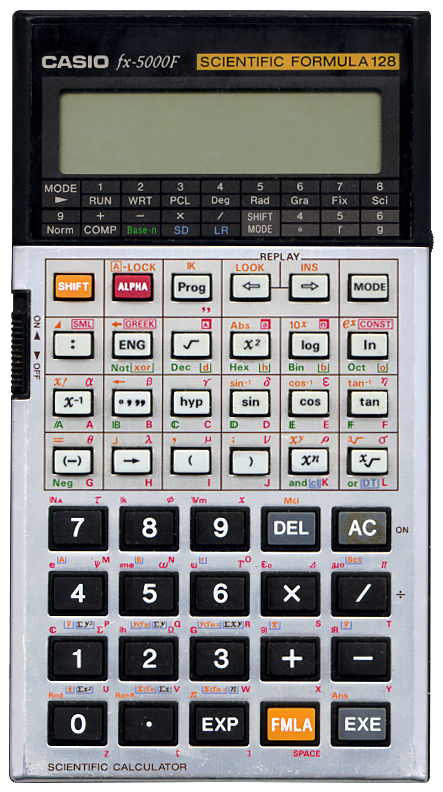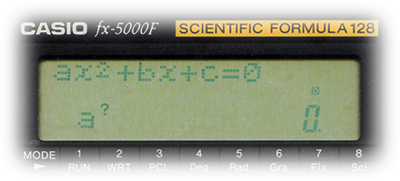
Terminated: unknown
 The formulae can be accessed by typing their ordinal number
followed by the
FMLA key.
The formulaes’ numbers
are listed in a small folder that can be stored in the calculators
foldable flap. When requesting a formula the formula is shown in
the alphanumerical upper part of the display. These formulae have
unknowns which the calculator queries (after entering use the
EXE key
to continue) before showing the result of the
formula. A large part of the manual lists all 128 formulae and their
meaning.
The formulae can be accessed by typing their ordinal number
followed by the
FMLA key.
The formulaes’ numbers
are listed in a small folder that can be stored in the calculators
foldable flap. When requesting a formula the formula is shown in
the alphanumerical upper part of the display. These formulae have
unknowns which the calculator queries (after entering use the
EXE key
to continue) before showing the result of the
formula. A large part of the manual lists all 128 formulae and their
meaning.
Formulae can be entered in WRT (write) modus. They can easily be navigated using the ⇦ ⇨ arrow keys and edited using the INS function and the DEL key.
Next to all the formulae, it also has has a library of 13 scientific constants. They are accessible by first pressing the ALPHA key followed by the CONST function (above the Ln key) followed by one of 1 ... 9 or one of +, −, × or /.
Next to being a formula-device it is also a capable scientific and statistical calculator. It also does BASE-n calculations.
Calculations can also be recalled and edited by pressing the ⇦ or ⇨ arrow keys.
When I saw a picture of this calculator I knew I had to have one. Until I knew of this calculator I was of the opinion that the TI-68 was the one with the most convoluted keyboard layout, this one is even more so. For me (all right I’m 59 years old when I type this), I can not use this calculator without reading glasses. Some of its keys ave 6 different functions!
Still, when you get used to it, things start falling into place. It’s actually not so bad as it looks. For instance, when working with BASE-n calculations, only pay attention to all the green labels. The orange SHIFT key’s functions are all labelled in orange (or an orange frame for shifted BASE-n operations). All physical constants are top-left to most of the keys in the lower part. Greek symbols are top-right. Statistical functions are in blue. Alphanumeric letters and symbols are on the bottom-right and can be accessed after pressing the ALPHA key.
But reading glasses are advisable.
This 10 minute YouTube video (link validated 2025-12-06) by Calculator Culture has a nice demo of this calculator.